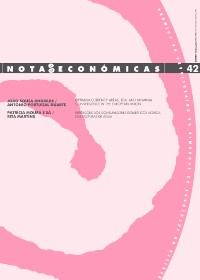Please use this identifier to cite or link to this item:
https://hdl.handle.net/10316.2/38326| Title: | Optimum currency areas, real and nominal convergence in the European Union | Authors: | Andrade, João Sousa Duarte, António Portugal |
Keywords: | Monetary integration;Optimum Currency Areas;real and nominal convergence;unit roots and fractional differentiation | Issue Date: | 2015 | Publisher: | Imprensa da Universidade de Coimbra | Abstract: | It is well known and widely accepted by economists that the characteristics of the countries of the European Monetary Union (EMU) created in 1999 did not match the requirements of an Optimum Currency Area (OCA). The only criteria for membership of the EMU were nominal. A strict level of convergence in inflation and interest rates was imposed. In addition to the nominal convergence, a process of convergence of nominal and real incomes in the new monetary area was expected to be generated with the monetary integration. After summarizing the criteria for a successful currency area in the context of the OCA theory, we study the real and nominal convergence process for an older group of countries (11) to establish whether or not these countries satisfy the conditions of an OCA. We apply ADF tests, together with the Schmidt-Phillips tests, and we estimate the fractional differential process to overcome the disadvantages of the traditional tests, to test for nominal and real convergence. We conclude that a process of real divergence and nominal convergence does exist, and suggest this is a source of genuine imbalance in the European integration process that can destroy the harmonious development of the European Monetary Union. | URI: | https://hdl.handle.net/10316.2/38326 | ISSN: | 2183-203X (digital) 0872-4733 |
DOI: | 10.14195/2183-203X_42_1 | Rights: | open access |
| Appears in Collections: | Notas Económicas |
Files in This Item:
| File | Description | Size | Format | |
|---|---|---|---|---|
| optimum_currency_areas__real_and_nominal_convergence.pdf | 3.97 MB | Adobe PDF |  |
Items in DSpace are protected by copyright, with all rights reserved, unless otherwise indicated.
